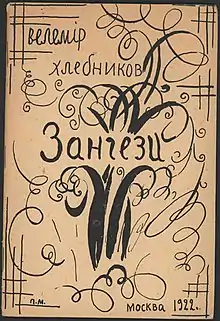Zaum
Zaum (Russian: зáумь) are the linguistic experiments in sound symbolism and language creation of Russian Futurist poets such as Velimir Khlebnikov and Aleksei Kruchenykh. Zaum is a non-referential phonetic entity with its own ontology. The language consists of neologisms that mean nothing. Zaum is a language organized through phonetic analogy and rhythm.[1] Zaum literature cannot contain any onomatopoeia or psychopathological states.[2]

Usage
Aleksei Kruchenykh created Zaum in order to show that language was indefinite and indeterminate.[2]
Kruchenykh stated that when creating Zaum, he decided to forget grammar and syntax rules. The reason for this was that introducing disorder into the language would better convey the disorder of life. Kruchenykh considered Zaum to be the manifestation of a spontaneous non-codified language.[1]
Khelinbov believed that the purpose of Zaum was to find the essential meaning of word roots in consonantal sounds. He believed such knowledge could help create a new universal language based on reason.[1]
Examples of zaum include Kruchenykh's poem "Dyr bul shchyl",[3] Kruchenykh's libretto for the Futurist opera Victory over the Sun with music by Mikhail Matyushin and stage design by Kazimir Malevich,[4] and Khlebnikov's so-called "language of the birds", "language of the gods" and "language of the stars".[5] The poetic output is perhaps comparable to that of the contemporary Dadaism but the linguistic theory or metaphysics behind zaum was entirely devoid of the gentle self-irony of that movement and in all seriousness intended to recover the sound symbolism of a lost aboriginal tongue.[6] Exhibiting traits of a Slavic national mysticism, Kruchenykh aimed at recovering the primeval Slavic mother-tongue in particular.
Kruchenykh would author many poems and mimeographed pamphlets written in Zaum. These pamphlets combine poetry, illustrations, and theory.[1]
In modern times, since 1962 Serge Segay was creating zaum poetry.[7] Rea Nikonova started creating zaum verses probably a bit later, around 1964.[8] Their zaum poetry can be seen e.g. in issues of famous "Transponans" samizdat magazine.[9] In 1990, contemporary avant-garde poet Sergei Biriukov has founded an association of poets called the "Academy of Zaum" in Tambov.
The use of Zaum peaked from 1916 to 1920 during World War I. At this time, Zaumism took root as a movement primarily involved in visual arts, literature, poetry, art manifestoes, art theory, theatre, and graphic design,[10] and concentrated its anti war politic through a rejection of the prevailing standards in art through anti-art cultural works. Zaum activities included public gatherings, demonstrations, and publications. The movement influenced later styles, Avant-garde and downtown music movements, and groups including surrealism, nouveau réalisme, Pop Art and Fluxus.[11]
Etymology and meaning
Coined by Kruchenykh in 1913,[12] the word zaum is made up of the Russian prefix за "beyond, behind" and noun ум "the mind, nous" and has been translated as "transreason", "transration" or "beyonsense."[13] According to scholar Gerald Janecek, zaum can be defined as experimental poetic language characterized by indeterminacy in meaning.[13]
Kruchenykh, in "Declaration of the Word as Such (1913)", declares zaum "a language which does not have any definite meaning, a transrational language" that "allows for fuller expression" whereas, he maintains, the common language of everyday speech "binds".[14] He further maintained, in "Declaration of Transrational Language (1921)", that zaum "can provide a universal poetic language, born organically, and not artificially, like Esperanto."[15]
Major zaumiks
Notes
- Terras, Victor (1985). Handbook of Russian Literature. London: Yale University Press. p. 530. ISBN 978-030-004-868-1.
- Kostelanetz, Richard (2013). A Dictionary of the Avant-Gardes. New York: Taylor&Francis. ISBN 978-113-680-619-3.
- Janecek 1996, p. 49.
- Janecek 1996, p. 111.
- Janecek 1996, pp. 137–138.
- Janecek 1996, p. 79.
- Кузьминский К., Ковалёв Г. Антология новейшей русской поэзии у Голубой Лагуны. — Т. 5Б.
- Жумати, Т. П. (1999). "«Уктусская школа» (1965-1974) : К истории уральского андеграунда". Известия Уральского государственного университета. 13: 125–127.
- Transponans, made available online by Toronto University
- Janecek 1984, pp. 149–206.
- Knowlson 1996, p. 217.
- Janecek 1996, p. 2.
- Janecek 1996, p. 1.
- Janecek 1996, p. 78.
- Kruchenykh 2005, p. 183.
References
- Janecek, Gerald (1984), The Look of Russian Literature: Avant-Garde Visual Experiments 1900-1930, Princeton: Princeton University Press, ISBN 978-0691014579
- Janecek, Gerald (1996), Zaum: The Transrational Poetry of Russian Futurism, San Diego: San Diego State University Press, ISBN 978-1879691414
- Kruchenykh, Aleksei (2005), Anna Lawton; Herbert Eagle (eds.), "Declaration of Transrational Language", Words in Revolution: Russian Futurist Manifestoes 1912-1928, Washington: New Academia Publishing, ISBN 978-0974493473
- Knowlson, J. (1996), The Continuing Influence of Zaum, London: Bloomsbury
External links
- Chapter Nine of G. Janecek, Zaum: The Transrational Poetry of Russian Futurism
- Janecek's Zaum, published by San Diego State University Press
- Lecture by Z. Laskewicz: "Zaum: Words Without Meaning or Meaning Without Words? Towards a Musical Understanding of Language"
- 'Locating Zaum: Mnatsakanova on Khlebnikov' an essay by Brian Reed
- Article by A. Purin: "Meaning and Zaum" (in Russian)
- Tambov Academy of Zaum, Cyrillic KOI8-R encoding (in Russian)
- Samizdat books and artist' books by Serge Segay, some with zaum and visual poetry
- Samizdat books and artist' books by Ry Nikonova, some with zaum and visual poetry
